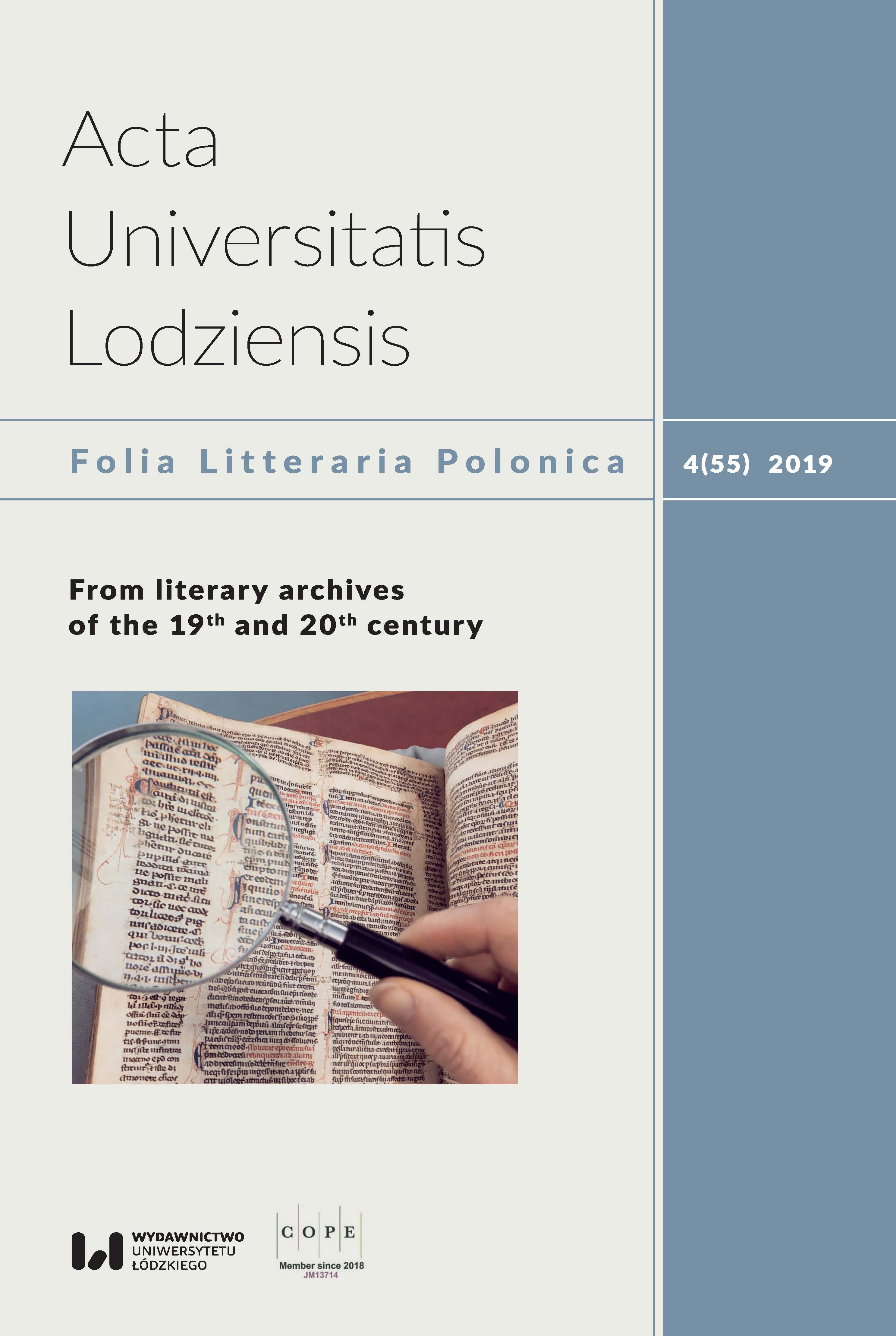Bulletins of the Polish censorship office from 1945 to 1956. A reconnaissance study
DOI:
https://doi.org/10.18778/1505-9057.55.15Keywords:
classified bulletins of the censorship office, censorship in post-war Poland, censorship of literature, censor, cryptotextsAbstract
The aim of the article is to discuss selected research perspectives offered by the bulletins of the censorship office created in Poland from 1945 to 1956. Due to the chiefly confidential nature of the analysed documents I defined them as classified papers, ordered by the state, directed mainly to censors. These documents were internally circulated in the Main and Voivodship Offices of Control of Press, Publications and Shows. Due to their aim bulletins played an informational, tutorial or training role, and functioned as a type of a guide for censorship practices. Due to the distribution they are cryptotexts (i.e. classified texts of intentionally limited distribution). In the article I discussed the state of knowledge on the bulletins and I also considered the context-based identity conditions of the periodical. I indicated the pitfalls which accompany any attempt at recreating the profile of the implied censor and I discussed the language of the bulletins. I also indicated the content of the paper. Bulletins presented mainly the materials on censorship and on the organisations of work in the Office of Control. The research material consists of both articles from the editorial office and from the voivodship’s offices (i.e. censorship reviews, reports, letters from the censor units or from the particular censors) and even literary attempts of the censors themselves.
Downloads
References
B. D. [Beata Dorosz], Iwaszkiewicz Jarosław, in: Współcześni polscy pisarze i badacze literatury. Słownik biobibliograficzny, vol. 3: G–J, J. Czachowska, A. Szałagan (eds.), Wydawnictwa Szkolne i Pedagogiczne, Warsaw 1994, pp. 317–334.
Google Scholar
“Biuletyn Informacyjno-Instrukcyjny”. Wybór dokumentów z 1955 r., Kamila Budrowska, Magdalena Budnik, Wiktor Gardocki (eds.), Wyd. UwB, Białystok 2018, series: Cenzura w PRL. Archiwalia, t. 3.
Google Scholar
Budrowska Kamila, Literatura i pisarze wobec cenzury PRL 1948–1958, Wyd. UwB, Białystok, 2009.
Google Scholar
Budrowska Kamila, O niestosownych zastosowaniach literatury w cenzorskich materiałach instruktażowych, “Litteraria Copernicana” 2013, issue 2, pp. 8–17.
Google Scholar
Budrowska Kamila, Wewnętrzne pismo cenzury. “Biuletyn Informacyjno-Instrukcyjny” w latach 1952–1955, in: Budrowska Kamila, Studia i szkice o cenzurze w Polsce Ludowej w latach 40. i 50. XX wieku, Wyd. UwB, Białystok 2014, pp. 95–106.
Google Scholar
Ciecierski Tadeusz, Zależność kontekstowa. Wprowadzenie do problematyki, Ośrodek Badań Filozoficznych, Warsaw 2011.
Google Scholar
E. G. [Ewa Głębicka], Wasilewska Wanda, in: Współcześni polscy pisarze i badacze literatury. Słownik biobibliograficzny, vol. 9: W–Z, J. Czachowska, A. Szałagan (eds.), Wydawnictwa Szkolne i Pedagogiczne, Warsaw 2004, p. 49–56.
Google Scholar
Encyklopedia wiedzy o książce, Aleksander Birkenmajer, Bronisła Kocowski, Jan Trzynadlowski (eds.), Ossolineum, Wrocław 1971.
Google Scholar
Głowiński Michał, Nowomowa i ciągi dalsze. Szkice dalsze i nowe, Universitas, Cracow 2009.
Google Scholar
Gogol Bogusław, “Fabryka fałszywych tekstów”. Z działalności Wojewódzkiego Urzędu Kontroli Prasy, Publikacji i Widowisk w Gdańsku w latach 1945–1958, Neriton, Warsaw 2012.
Google Scholar
Iwaszkiewicz Jarosław, Summer at Nohant. A play in 3 acts, transl. Celina Wieniewska, Minerva Publ. Comp., London 1942.
Google Scholar
Kopaliński Władysław, Słownik wyrazów obcych i zwrotów obcojęzycznych, Wiedza Powszechna, Warsaw 1991.
Google Scholar
Markiewicz Henryk, Wymiary dzieła literackiego, Universitas, Cracow 1996.
Google Scholar
Nałęcz Daria, Główny Urząd Kontroli Prasy 1945–1949, ISP PAN, Warsaw 1994, series: Dokumenty do Dziejów PRL, issue 6.
Google Scholar
Nowak Piotr, Cenzura wobec rynku książki. Wojewódzki Urząd Kontroli Prasy, Publikacji i Widowisk w Poznaniu w latach 1946–1955, Wyd. UAM, Poznań 2012.
Google Scholar
Nowak Piotr, Wojewódzki Urząd Kontroli Prasy, Publikacji i Widowisk w okresie nacjonalizacji rynku książki w Poznaniu (1946–1955), “Biblioteka” 2011, issue 15(24), pp. 163–193.
Google Scholar
Romek Zbigniew, Cenzura a nauka historyczna w Polsce. 1944–1970, Neriton, Warsaw 2010.
Google Scholar
Sartre Jean-Paul, Czym jest literatura, trans. Janusz Lalewicz, PIW, Warsaw 1968.
Google Scholar
Tyszkiewicz Barbara, Sztuka czytania między wierszami. Z problematyki cenzorskich instruktaży drugiej połowy lat 70., in: “Sztuka czytania między wierszami”. Cenzura w komunikacji literackiej w Polsce w latach 1965–1989, Kamila Budrowska, Maria Kotowska-Kachel (eds.), IBL PAN, Warsaw 2016, series: Badania Filologiczne nad Cenzurą PRL, t. 6, pp. 127–158.
Google Scholar
Wasilewska Wanda, Rzeki płoną, Wyd. MON, Warszawa 1952.
Google Scholar
Wiśniewska-Grabarczyk Anna, “Czytelnik” ocenzurowany. Literatura w kryptotekstach – recenzjach cenzorskich okresu stalinizmu (na materiale GUKPPiW z roku 1950), Wyd. IPN, Warsaw 2018.
Google Scholar
Wiśniewska-Grabarczyk Anna, “O wyższy poziom pracy nad książką” – biuletyny urzędu cenzury z lat 1945–1956 w perspektywie literaturoznawczej. Rekonesans, in: Cenzura w PRL. Analiza zjawiska, Zbigniew Romek, Kamila Kamińska-Chełminiak (eds.), ASPRA-JR, Warsaw 2017, pp. 61–74.
Google Scholar
Wiśniewska-Grabarczyk Anna, Recenzja cenzorska Polski Ludowej, “Zagadnienia Rodzajów Literackich” 2016, vol. 1, issue 59(117), pp. 97–103.
Google Scholar
Wiśniewska-Grabarczyk Anna, Segment streszczający recenzji cenzorskiej, “Socjolingwistyka” 2016, issue 1(30), pp. 277–288.
Google Scholar
Wiśniewska-Grabarczyk Anna, The censorship review in the Polish People’s Republic as cryptotext, “The Polish Review” 2019, vol. 64, no. 1, pp. 31–49.
Google Scholar
Woźniak-Łabieniec Marzena, Wokół recepcji Traktatu polemicznego Witolda Wirpszy. Głosy o Miłoszu w roku 1951 w świetle dokumentów cenzury, “Acta Universitatis Lodziensis. Folia Litteraria Polonica” 2011, issue 2(12), pp. 152–163.
Google Scholar
Downloads
Published
How to Cite
Issue
Section
License

This work is licensed under a Creative Commons Attribution-NonCommercial-NoDerivatives 4.0 International License.










